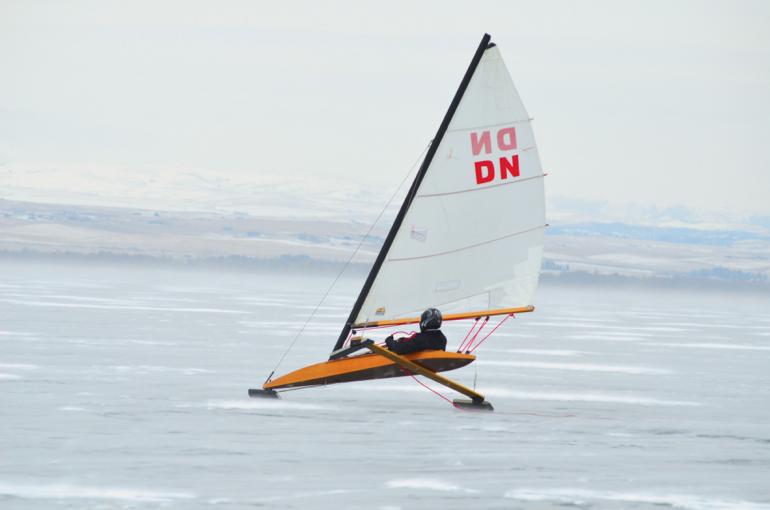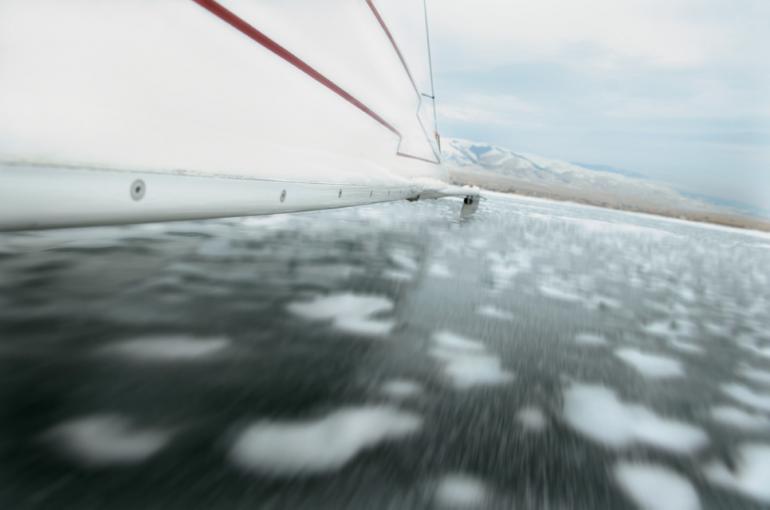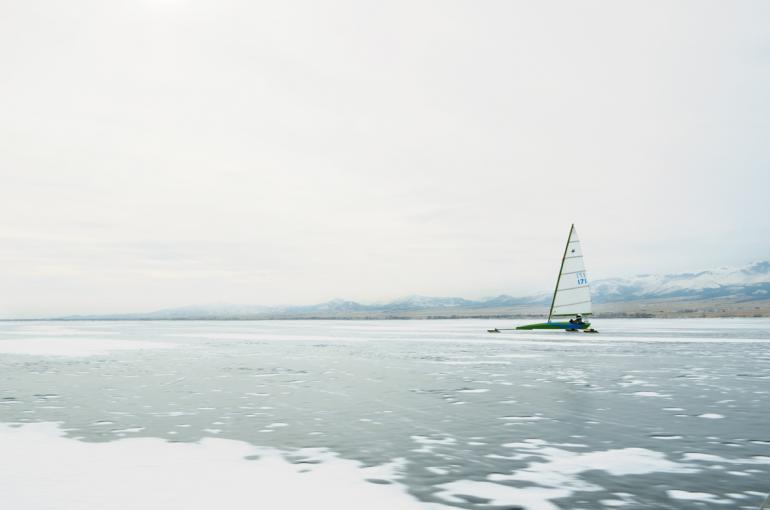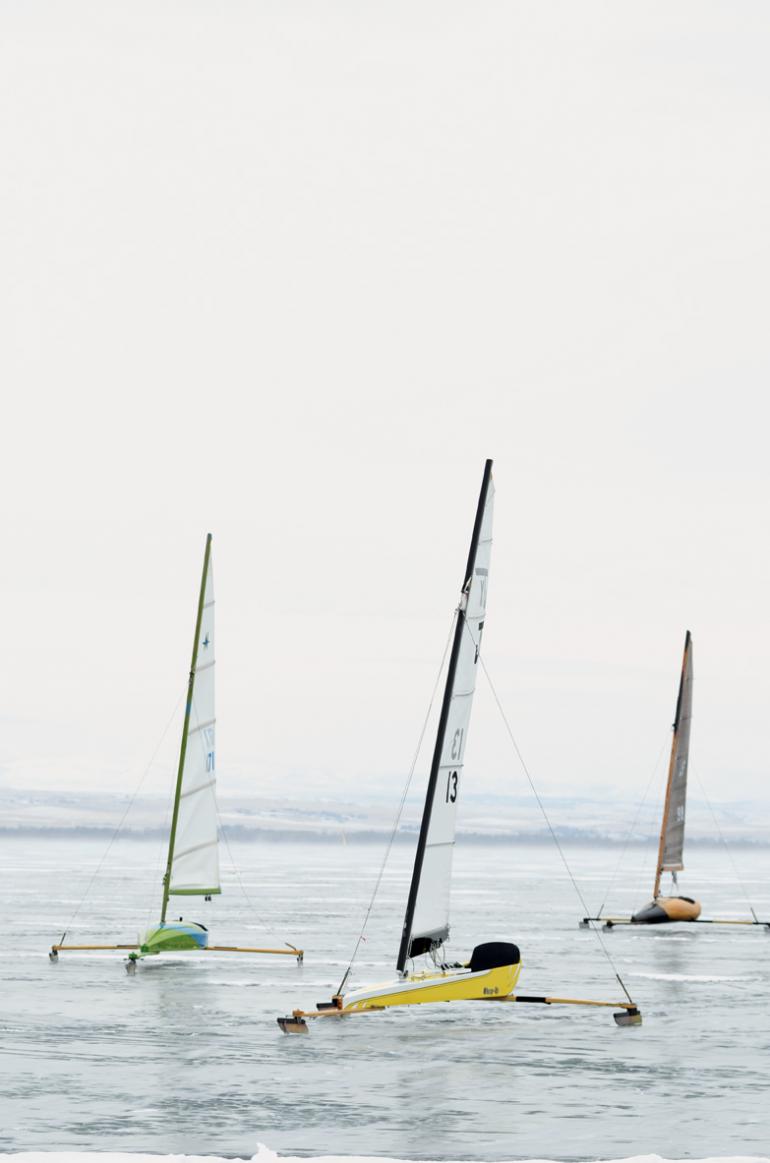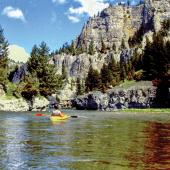Fear and Ice Boating on Canyon Ferry
The growth of an ice boating community.
Blasting across the frozen wasteland of Canyon Ferry Lake, the skinny fiberglass frame of the ice boat rattles like an unbalanced washing machine. Hardened-steel runners spit ice chips at me, the tiny bullets bouncing off the face shield of my helmet. With each buck and turn, my ass oozes lower into the boat while I curl my feet up in a clumsy fetal position, trying to keep them off the pedals hidden near the bow. This is not fun. This is dangerous.
“What do you want? You wanna go faster?” Dave shouts, struggling just to be heard over the roaring wind and chattering skates. That’s Dave Gluek, a Wisconsin transplant who’s been ice boating for the last 50 years. Right now, he’s completely in his element, full of the energy that makes dogs dance just before they get fed. Dave’s one of the godfathers of the sport, and now it seems like he’s going to kill me.
Terrified, I hoist myself into a sitting position, bumping my helmet against his and I yell as loud as possible over the wind. “Faster? No. Not faster! Maybe some hot cocoa with peppermint schnapps… or some health insurance! Maybe a chance to make peace with God before I end up one big red smear on Canyon Ferry Lake! NOT FASTER!”
He doesn’t hear a thing. My words come out garbled through a balaclava and full-face racing helmet, sucked out from behind the plastic face shield and lost in the cold wind forever. My incomprehensible grunting only seems to have encouraged him.
Way back when Reagan was in office, there were only about three people out here enjoying the ice. With considerable help and guidance from Carl Harper, Dave’s hard work has helped Canyon Ferry become internationally famous for its iceboating conditions—half for the excellent conditions of hard freezes, little snow, and continual strong wind, and half for the scene he’s built. Over the last 20 years, Dave’s been supplying central Montana with ice boats—vessels hauled back from numerous trips to the Midwest, or ones he built with his own hands. And he’s never made a nickel of profit off his tireless building, hauling, and selling. He does it purely for the love of the sport and to help other people enjoy into it. A few decades later, dozens convene each weekend to play on the ice.
Dave flashes a big smile and yells back over the wind, “You wanna go faster? Okay! Let’s really get this thing moving!” Leaning forward, he grabs as much of the thick rope as possible and leans back hard, pulling the sail taught and rocketing the ice boat even faster than before. We’re threaded into the red stitches on God’s fastball. Newspaper headlines flash through my mind:
Local Journalist Killed in Ice-Boating Accident
He looks down at his shoulder-mounted GPS and yells over, “38 miles per hour!” A big smile blooms over his pink, wind-chapped face and he pulls again at the rope. “Now we’re talking!” We approach light speed.
“He Said ‘Go Faster!’” Claims Driver
In a car, traveling at 38 miles per hour, you’re crawling.
In an ice boat, traveling at 38 miles per hour, the world is coming to an end. Like the scariest roller coaster you’ve ever been on, without the steel cages or tracks or safety equipment or carnies or anything that gives the impression that this is all perfectly normal and you just might survive the ordeal intact.
Dave banks a hard left turn and the g-forces crush my ribcage into the right edge of the hull, the boom knocking against my helmet. His laughter bubbles up through the freezing wind. My pulse thuds in my ears, mostly because my heart is working overtime just to get blood to my brain.
He turns the boat into the wind and the vessel loses speed. Dave yells, “You wanna go in for a little bit? Or you wanna take another lap?” He loosens his grip on the thick rope of the main sheet, letting the sail go lax. The boat, finally not propelled by the invisible furious hand of God, begins to coast across the ice. Peace is returning to the world. The great twisted washcloth of my guts slowly starts to unwind and I stop to think, carefully, about what to tell my ice-boat pilot.
I get that feeling. The one little kids get after you swing them around in a circle by their ankles, until they bawl and scream and you let them down—but they run up to you all bright-eyed and yell, “again!” I’m that conflicted, deranged little kid. But since my face is numb, my hands are worthless wooden blocks, and I’m about to hurl, I lean over and say, “No thank you.”
“No problem,” he says, “we can take ‘er in for a little bit. We’ll let ya warm up and we’ll go out again later.” The ice near shore is even choppier, so as our boat chatters back towards the dozen other moored boats, it bounces and whinnies like a racehorse in from the first training run of the season. Dave claps his hands together, beaming, and leans over towards me, asking if I had a good time.
The sour-milk taste of vomit foams up into my mouth. “Something like that,” I say, “I just wanna go back to the car for a little bit.”
Despite this inadvertent attempted homicide, Dave Gluek is probably the most genuinely kind person you’ll ever meet. That Midwest nice. Garrison Keillor nice. He’d be happy to give you the shirt right off his back—or in this case, nearly everything from the duffel bag in his horse trailer full of equipment. When I arrived, he laughed at my thin softshell and blue jeans, then dressed me in half a dozen layers of warm clothing before we went out. I’ll leave still wearing his spare socks, and he’ll tell me to keep them.
Driving slow and careful through the other boats, he says, “It’s a shame I can’t take you out in my other boat.” He’s talking about his 30-foot skeeter named “Tunnel Vision” that looks like a purple rocket ship. “I’ve gotten it up to nearly 70 miles per hour. Really fun stuff.” The skates hiss and the boat crawls to a stop. Dave tells me I should come back again soon. There’ll be a guy coming over from England aiming to set the world speed record, and he’ll have to top 128 mph to do it.
I scramble out of the boat. “Don’t run on the ice!” he calls out. The wind—and the sound of the steel spikes on my boots crunching across the thick black ice—almost erases his words before they get to me.
And so I survive my first ice-boat ride. Just barely. As soon as my body thaws, we go out again, but faster this time.
Boarding the Boat
“As soon as we get one hard frost, Canyon Ferry is ready for ice boating… the season usually runs from about Christmastime to mid-March, give or take. Anybody is welcome to come and take a ride-along in one of our boats—we’re here most weekends, and I bring down a horse trailer with extra helmets, warm clothes, ropes, emergency supplies, a barbeque, everything. One weekend, we ended up with over a hundred people down on the ice, just boating, eating, talking… it was quite a party. Some were just folks who saw us from the highway and wanted to check things out.” —Dave Gluek, ice boating aficionado


